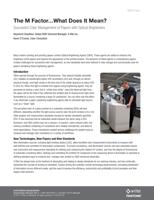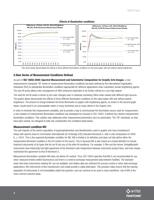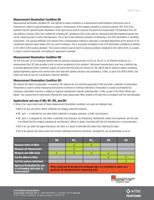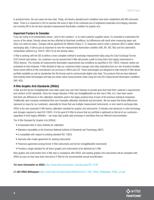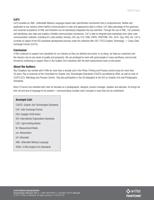
White Paper
In practical terms, the use cases are less clear. Today, all industry standard print conditions have been established with M0 instrumen-
tation. There is a movement in ISO to examine this issue in light of the continued use of brightened substrates and imaging colorants,
but currently M0 is the de facto standard measurement illumination condition for graphic arts.
Important Factors to Consider
If you are trying to hit standardized values, “print to the numbers,” or to meet customer supplied values, it’s essential to understand the
source of the values. Density values are less affected by illuminant conditions, but differences will result when measuring paper and
other non-solid ink colors. Changes will be significant for different Status (T, E) responses and/or when a polarizer (M3) is added. When
exchanging data, it will be just as important to note the measurement illumination condition (M0, M1, M2, M3) and the colorimetric
computation method (e.g. D50/2, D65/10) as the density status.
X-Rite is working with the ISO to define a more complete method to exchange measurement data using the Color Exchange Format
[CxF] format (see below). Our customers can be assured that X-Rite will provide a path to bring them from legacy instruments to
XRGA devices. This includes all measurement illumination requirements and conditions as specified in ISO 13655. However, before we
embarked on that endeavor, X-Rite decided to help our customers better manage color data originating from our mix of product families.
Some recent efforts of this commitment can be found in XRGA and CxF. These technologies are designed to help minimize X-Rite device
portfolio variability as well as standardize the file format used to communicate digital color data. The products that we have delivered
that embody these technologies will help you better utilize measurements made using the new ISO measurement illumination conditions
(M0–M3).
X-Rite Graphic Arts Standards [XRGA]
X-Rite and the former GretagMacbeth have taken great care over their histories to provide tools that meet their customer’s requirements
and conform to ISO standards. Since the merger between X-Rite and GretagMacbeth we (the new X-Rite, Inc.) have been aware
that there are differences in the calibration standards used in the legacy product lines of each of the previous individual companies.
Traditionally each company maintained their own traceable calibration standards and processes. We are aware that these differences
represent an issue for our customers, especially for those that use multiple measurement instruments, or who need to exchange data.
XRGA is the new corporate X-Rite factory calibration standard for graphic arts instruments. It includes new advances in color technology
and changes required to meet ISO-13655. It is the goal of X-Rite to ensure that our portfolio is optimized so that all of our customers –
regardless of their legacy affiliation – can enjoy high quality data exchange in workflows that use different instrumentation.
The X-Rite Standard for Graphic Arts [XRGA] :
• Incorporates best in class methods for calibration
• Maintains traceability to the American National Institute of Standards and Technology (NIST)
• Is compatible with respect to existing standard ISO 13655
• Improves inter-model agreement for existing instruments
• Preserves agreement among former X-Rite instruments and former GretagMacbeth instruments
• Provides a single standard for all future graphic arts instruments to be delivered by X-Rite
New graphic arts instruments from X-Rite ship in compliance with XRGA, and existing graphic arts instruments will be compliant with
XRGA as soon as they have been returned to X-Rite for the recommended annual recertification.
For more information on XRGA: http://www.xrite.com/product_overview.aspx?ID=1336
L7-462 XRGA Whitepaper: http://www.xrite.com/documents/literature/en/L7-462_XRGA_Whitepaper_FINAL_en.pdf
4

